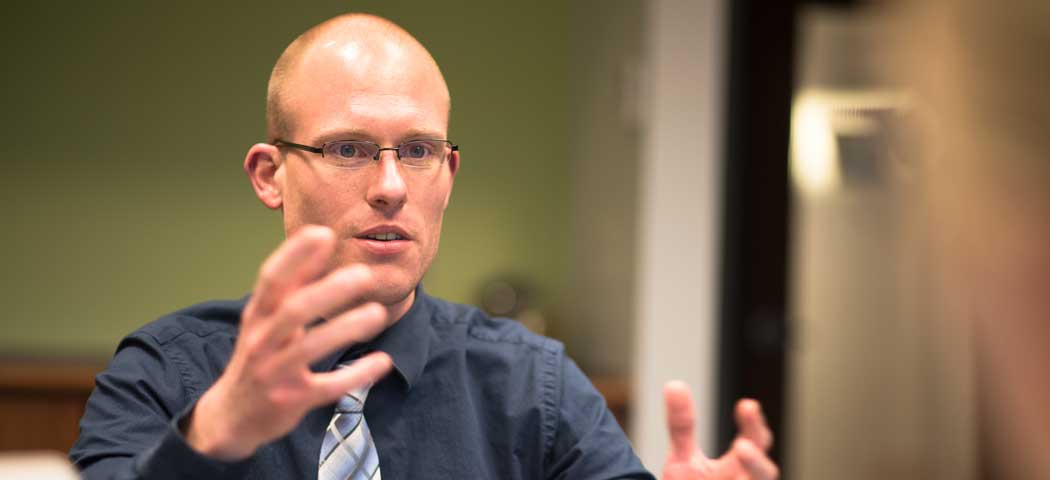
The Diocese of Madison
Madison, WI
The Diocese of Madison features 44 different Catholic schools in southwest Wisconsin. The diocese serves more than 6,500 students.
Michael Flanagan’s parents were educators—music teachers, to be precise—and while that fact shaped his early life, he never imagined he would become an educator himself. “It wasn’t that I disliked the idea—I just never imagined going the same route,” he says. Whether it was destiny, genetics, or his love for music and the arts, Flanagan found himself majoring in music education at Northern Illinois University, and taught choir and musical theater for several years in a public high school.
Today, Flanagan is assistant superintendent of the Catholic schools for the Diocese of Madison, Wisconsin. When asked about his career trajectory, he laughs and says, “Well, I love music—but I also love instructional technology.”
Instructional technology and music education are two phrases that may not appear together often, but as Flanagan’s education career continued, he started to think about the combination of the two. He started to use a bit of technology in his choir and musical theater classes—until a major life event revealed just how useful technology could be for him and his students on a regular basis.
“During my third year of teaching, my wife went into labor with our child in the middle of the semester,” Flanagan recalls. “It was our first child, and I took a week off from work. Not wanting my class to fall behind, I assigned my students a project that they had to submit through an online portal. I joke about it now, but while my wife was waiting to go into labor, I was by her bedside grading my students’ assignments from the portal. The technology allowed me to interact with my students and keep my class on track. That was the moment when I realized how great of an asset technology can be in the classroom.”
“As a former music teacher, I tend to think in incremental elements,” continues Flanagan. “For instance, in a band, trumpets do one thing, drums do another, and so on. Very miniscule parts all come together to create something whole. It’s very similar to student data coming together to reveal an entire view of student growth and achievement.”

The challenge
Changing a decades-old process
Flanagan’s love of incorporating technology in his lesson plans led to a position as a teacher and eventually a principal in one of Madison’s Catholic elementary schools. Because of his public school background, where there was a large emphasis on data literacy, Flanagan realized that the Diocese of Madison could benefit from the same type of information—data to truly understand where the students at the schools were and how that could impact instruction and curriculum in a big way.
When Flanagan assumed his assistant superintendent role, one of the first things he wanted to improve was the diocese’s student assessment solution. Simply put, the assessment that had been in place previously did not have an impact on the curriculum. The schools had been using old multiple-choice bubble tests, similar to the old models of Wisconsin’s state assessment. Results took weeks to arrive, were vague, and offered little value. “It was basically a plot graph comparing our students to the national norms on one sheet,” says Flanagan. “It was easy to administer, but it did not do anything to enhance student learning. Our teachers and principals did not find it useful. In fact, teachers simply described the assessment solution as ‘not really an option, just something that the schools have to administer.’” Flanagan knew something had to change.
The schools had already taken a step in this direction by forming an assessment committee, which Flanagan was elected to lead prior to his assistant superintendent role. With 44 schools and 6,500 students in all different types of rural and urban settings, Flanagan knew any new solution the diocese adopted needed to achieve two things—it needed to have a direct impact on instruction throughout the diocese, and it needed to be extremely flexible.
Principals, teachers, and others in the Madison Diocese also needed to be able to pick up the assessment solution and implement it with ease, and the implementation needed to be thoughtful and account for the learning styles of all diocese educators. After several vendor presentations and discussions, Flanagan and others kept coming back to Renaissance Star 360®.
“For us, it was Star 360’s emphasis on RTI,” says Flanagan. “RTI is often thought of as only being useful for at-risk students, but it really is to help all students learn and grow, whether that’s at-risk students, gifted and talented students, and all students in between.”
To achieve their goals of a deliberate, practical implementation, the committee decided to pilot Star 360 with a few selected schools. “Early in 2015, we showed a few of the principals a fraction of what they would be able to do with the solution,” says Flanagan. “There was no pushback—they were so amazed that all of this data could be at their fingertips.” During the pilot, other schools requested to use Star 360, and Flanagan and his committee did a lot of listening and observing before they rolled it out to a larger audience. “We listened to how each school in the pilot set up Star 360, how they used the assessment solution, and what questions they ran across,” recalls Flanagan. “Knowing that, we asked ourselves, ‘What can we anticipate from schools that have not had a similar product experience? What questions will they have?’”
Early in 2015, we showed a few of the principals a fraction of what they would be able to do with the solution. There was no pushback—they were so amazed that all of this data could be at their fingertips.
Michael Flanagan, Assistant Superintendent – Diocese of Madison, Wisconsin

Leading up to the rollout, each principal from the Madison Diocese was enrolled in several courses through Renaissance’s professional development service. “We worked with Renaissance to develop a nice mixture of on-site coaching and on-demand webinars, and our principals joined Renaissance’s Champions’ Academy,” says Flanagan. “By learning the fundamentals, each principal could go back to their respective schools and feel confident in implementing Star 360.”
“After experiencing some of the professional development Renaissance offers, I wouldn’t let anyone use their solutions without it,” says Flanagan. “Initially, we weren’t interested in the professional development, but I’m so glad we did. Even now, we’re enrolled in ongoing professional development so the principals always know what they should be experiencing and what is coming down the road.”
The results
A plethora of resources and information
Today, schools in the Madison Diocese give their students three assessments per year—one in September, one in January, and a final one in April. Several schools prefer to test their students at slightly different dates, which Flanagan says is fine—and part of the flexibility he appreciates. “We want the schools to have a window and pick the best time to test their students. Based on initial feedback from teachers, they are elated that they can see the skills their students are ready to learn. That was never available before.”
Diocese teachers also appreciate the suggested resources that Star includes to help teach students new skills. “Their eyes get really wide when they see that for the first time,” says Flanagan laughing. “Moving from something that used to be much different and restricted, Star 360 has been tremendous. Our weekly faculty meetings drive themselves now because our teachers actually want to talk about student growth and learning. They share tips and student trends they’ve picked up on. That’s incredible.”
Our weekly faculty meetings drive themselves now because our teachers actually want to talk about student growth and learning. They share tips and student trends they’ve picked up on. That’s incredible.
Michael Flanagan, Assistant Superintendent – Diocese of Madison, Wisconsin
“Star 360 has allowed our schools to break out of the mold of doing the same thing for 50-plus years. Teachers can ask, ‘Are the tools I’ve been using all this time working?’ The curriculum takes on a new shape,” says Flanagan.
“Our teachers are elated about using the data from Star 360, but they don’t call it ‘data.’ To them, it’s what students know and what they are ready to learn next. It’s actionable and they know what to do with it,” says Flanagan. “We can’t wait to see how Star 360 enhances our curriculum in the next five years.”

